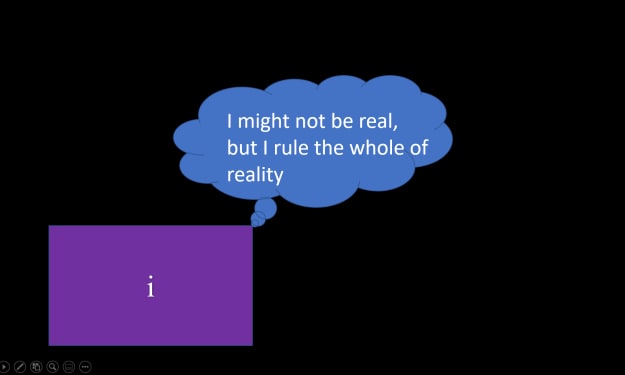Demystifying the Calculus
Explaining Calculus without using a single equation

Calculus is often considered the bane of mathematics. Terrifying many students, this discipline provides a unwelcomed bounty of equations and techniques, which bombard the student into retreat. The emphasis of calculus on solving equations and finding areas and volumes, does not encourage the student to forge on or show its true range of applicability. And when any reader opens up a book in quantum mechanics or other subjects requiring advanced mathematics, one keeps seeing a curly S and a weird looking fraction defined in terms of objects written in terms of ‘infinitesimals’. Therefore this article has been written, to fill the void of mathematical literature explained without equations. Here I shall attempt to explain the Calculus, without using a single equation. Ready? Well, to infinity and beyond!
Calculus is all about infinity, and how things behave close to limits. Calculus is in fact about what happens in the most extreme limit possible, the limit where the difference between two points becomes infinitesimal and approaches zero. In this way, it is natural that all of calculus concerns the transition from the discrete to the continuous, and it is there where its true power can be found.
So to begin with, let’s consider the junction between discrete summation and its continuous counter part. Discrete summation can be just called addition.
With addition, we add one apple to a basket, and then another, and then another. We can take the sum of the sequence at any point, and we will always obtain a whole number for the total number of apples to be found within the basket. We will not ever end up with a lonely half an apple wondering around. There are a discrete number of sums which can be obtained, depending upon when we call stop. It is worth noting that if we extend this addition for eternity and record the total number of apples each time an apple is added, there will be an infinite number of sums written down. In this sense there is a countably infinite number of possible sums I could obtain, but there are many sums which remain impossible to obtain and which we simply skip over.
We could repeat a similar sequence, but sum half an apple each time. In this case I could indeed sum such that I end up with lonely half apples, however lonely quarter apples are out of the question. However now more sums are possible.
We could then sum a quarter apples, and again the number of obtainable sums increases. Imagine we keep doing this, but we now approach the limit where we are summing infinitesimal segments of apple. An infinitesimal segment is a segment so small, that no finite summation of such infinitesimals will ever recreate an entire apple. What happens if we now add all terms, and keep going forever?
The segments we are adding are then so small that we could get to any value for the sum, it is just a matter of what infinitesimal we stop at. We are also now summing things such that we have no measurable gap between consecutive terms, and so we are dealing with continuous summation. Such a continuous sum is an integral. It looks like a very large curly S, and indeed one can think of it as a VERY massive summation. It has its own name, since it is very unlike the kind of sums we are doing in daily life and is used extensively in maths and science.
If you where to take a macroscopic object, split it into a infinite set of infinitesimal masses, and then sum them all together, you would be integrating. That’s all it is! But why would you want to do this? Surely according to this idea, when your integrating aren’t you just doing something, then completely undoing it, to end reconstruct the exact same object you began at? Well it turns out both yes and no. It all depends on what you do in that passing moment between splitting an object up and recreating it.
It turns out playing with the infinitesimals before you reconstruct the object, can be of great usefulness. For example consider the case where you approximate the area under a curve, between two points separated by a finite distance. Lets assume you do this using a finite number of rectangles, then these rectangles will be able to describe the area approximately. The more you have the better the approximation.
In the limit where you use an infinite number of infinitesimal rectangles, you’ve hit gold! Finding the area of a rectangle is easy, so once you know the area of the infinitesimal rectangles then you can add them all up, and find the exact area under a curve not matter how weird or wacky the curve is. The rectangles all have infinitesimal width and so have infinitesimal area. A given infinitesimal is weighted however by the height of its corresponding rectangle. The function gives the weighting, and in this encodes the information needed to find the total area.
Similarly Newton's and Coulomb’s laws in physics gives us descriptions for the forces generated by static point particles. If we split an object up into these point particles, then using integration, we can find the overall force generated by the object. We do integration because it allows us to find the properties of real world objects, by deriving it from the properties of the much simpler infinitesimal constituents.
In passing it is worth saying that integration has some wired quirks to. With some functions, when it is very hard to integrate it, you can multiply it by one, and suddenly it becomes easy to integrate. But surely multiplying by one leaves the function unchanged? Well yes, but I’ll leave this nugget to other works, its all about the fact that the integral of one, does not yield a constant. Calculus is a strange place I know, but that’s mathematics for you.
We have so far covered one half of the dime. Now, what about the other side of calculus, the differential. The differential is like the integral, in that it is concerned with limits and infinitesimals. It measures the rate of change of one variable with respect to another. It does this by considering how the two variables of interest change in relation to one another, in the limit that one change is infinitesimally small. It turns out a lot of derivatives can be conculcated directly from this definition, although sometimes derivative require techniques which are proven to work based on this definition. Such techniques include the quotient and the chain rule.
We can differentiate a function, to get a new function that describes how the variables change in relation to each other. We then differentiate this new function, and gain another function which we call the second order derivative. We can keep going like this, to arbitrarily large orders, though most physics stops worrying about things beyond the second derivative. The second derivative describes the rate of change of the rate of change. Imagine the function is a curve on a piece of paper. Well the rate of change of one variable with respect to another is described by the gradient or steepness of the curve. The second derivative is then the rate of change of this steepness, or else the curvature of the curve.
We can also construct sums of a function and its derivatives up to an arbitrary order. When we set this sum to equal something, we have a differential equation. The highest order of the derivative contained within the equation, is known as the order of the differential equation. As indicated by the name the anti-derivative which is sometimes used in place of the integral, there is a relationship between the derivative and the integral, and this can be used when solving first order differential equations.
All this concerns functions of two variables. Imagine we had three. Well we could keep the third fixed, and look at how only two of these change. This is called taking a partial derivative. Partial derivatives are the natural extensions of ordinary derivatives. Imagine we want to extend quantum theory from a 1D case, to the 3D world, well we replace ordinary with partial derivatives.
This is but a brief overview of calculus. It has far more to offer, but hopefully it has shown you that calculus is approachable and intuitive in its own way.
About the Creator
Reality Detective
Recently finished a Physics course at university. Now going into writing and exploring the world with the lens of fantasy and science.
Enjoyed the story? Support the Creator.
Subscribe for free to receive all their stories in your feed. You could also pledge your support or give them a one-off tip, letting them know you appreciate their work.






Comments
There are no comments for this story
Be the first to respond and start the conversation.